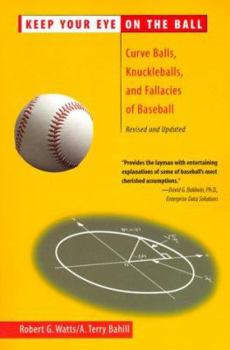Keep Your Eye on the Ball: Curve Balls, Knuckleballs, and Fallacies of Baseball
Select Format
Select Condition 
Book Overview
"Keep your eye on the ball " may be good advice--but it is impossible to do. The batter can track the ball until it is about five feet in front of the plate, but then he falls behind because the ball... This description may be from another edition of this product.
Format:Paperback
Language:English
ISBN:0716737175
ISBN13:9780716737179
Release Date:March 2000
Publisher:W. H. Freeman
Length:240 Pages
Weight:1.00 lbs.
Dimensions:0.8" x 6.1" x 9.2"
Customer Reviews
1 rating
Using science to understand baseball
Published by Thriftbooks.com User , 24 years ago
When asked if he was an athlete, a recently retired professional baseball player replied, "No ma'am, I'm a ballplayer." However, as this book clearly shows, if the question was, "Are you a practicing applied physicist?," the answer would have to be yes. While fascinating to read, this work points out how little science has contributed to the understanding of the game. And given that baseball is a billion dollar industry, this is surprising. The most interesting and astounding point made throughout the book is that to play baseball you must reason very quickly with estimates. For example, it is impossible for the human eye to track the path of a pitch thrown in excess of 90 miles per hour. To track a ball moving at 100 miles per hour as it crosses home plate, the body must respond at a rate in excess of 1000 degrees per second. And yet, studies are consistent in showing that the human limit is on the order of 90 degrees per second. It turns out that batters loose track of the ball as it nears them and extrapolate the data to actually hit it. Students lost sight of the ball when it was 9 feet away from them and professionals when it was 5.5 feet away. The absolute limit is on the order of 5 feet. The explanation of why a pitch will curve and what makes a knuckleball dance are truly works of art. And the physics of the best choice of bat in case you actually hit it should be required reading for all those who think they know baseball, players included. All are done using equations and example numbers rather than text. It is gratifying to find authors who ignore the adage about sales declining in direct proportion to the number of equations. Science and mathematics teaching is often(justly) criticized for lacking practicality. Well, what could be more practical than teaching someone to hit a baseball? This is one of those books where learning is fun. It could be used as a textbook for any course that deals with the physics of motion and force. And if class gets boring, you can always go out and hit a few. Published in Journal of Recreational Mathematics, reprinted with permission.






